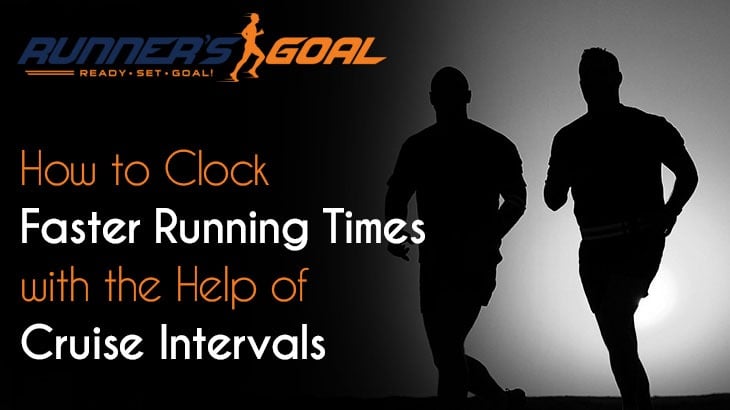Are you stuck on a running plateau? Have you been chasing the same old PB for years without success? Don’t throw in the towel just yet — we’ll show you how to clock faster running times with the help of cruise intervals.
What exactly are cruise intervals and how will it benefit you?
What exactly are cruise intervals, you ask? Cruise intervals were formulated by coach and running legend, Jack Daniels. Cruise intervals are one of three types of threshold training workouts aimed at increasing an athlete’s lactate threshold.
And although increasing your lactate threshold may sound technical, it’s actually quite simple. It is increasing the point at which your body becomes overwhelmed by lactic acid.
Lactic acid causes you to tire and stop running sooner. So, simply put, an increased lactate threshold will allow you to run faster for longer.
And how is this accomplished? Well, unlike tempo running, which is a steady run of at least 20 minutes at threshold pace (or a comfortably hard pace), cruise intervals use a run/rest approach to threshold training.
Instead of running at your threshold pace non-stop, the workout is divided into a number of threshold components separated by short periods of recovery.
Additional perks of cruise intervals
The good news is that in addition to increasing your lactate threshold, cruise intervals will allow you to run at a hard pace for longer. It also reduces the stress level of a generally stressful threshold workout. This is exactly what you want in terms of getting faster without the risk of getting injured.
How to structure a cruise interval training session
So how do you structure a cruise interval training session? It’s quite simple, really. Start off with a proper warm-up.
Then complete a number of 0.5 to 2-mile intervals at your threshold pace (i.e. a comfortably hard pace of 8 on a perceived effort scale of 1 to 10). Take 30 to 60-second recovery breaks in between.

Note that cruise intervals should generally not constitute more than 8% of your total weekly mileage. This means that if you run 20 miles per week, cruise intervals should not exceed 1.5 miles per week. Also, keep in mind that a hard workout like this one is best done only once a week.
If you are unsure about the pace, not to worry. Jack Daniels himself compiled this nifty pace chart to help you make sure that you’re hitting your personal threshold pace:
| Fitness Level Threshold Pace Per: 5K 10K 880 yd. 1320 yd. Mile |
| 27:00 | 56:03 | 4:41 | 7:02 | 9:22 | |
| 25:12 | 52:17 | 4:23 | 6:35 | 8:46 | |
| 24:08 | 50:03 | 4:13 | 6:20 | 8:26 | |
| 23:09 | 48:01 | 4:03 | 6:04 | 8:06 | |
| 22:15 | 46:09 | 3:53 | 5:50 | 7:47 | |
| 21:25 | 44:25 | 3:45 | 5:38 | 7:30 | |
| 20:39 | 42:50 | 3:37 | 5:26 | 7:15 | |
| 19:57 | 41:21 | 3:30 | 5:15 | 7:00 | |
| 19:17 | 39:59 | 3:24 | 5:06 | 6:48 | |
| 18:40 | 38:42 | 3:18 | 4:57 | 6:36 | |
| 18:05 | 37:31 | 3:12 | 4:48 | 6:24 | |
| 17:33 | 36:24 | 3:07 | 4:40 | 6:13 | |
| 17:03 | 35:22 | 3:01 | 4:32 | 6:03 | |
| 16:34 | 34:23 | 2:56 | 4:25 | 5:53 | |
| 16:07 | 33:28 | 2:52 | 4:18 | 5:44 | |
| 15:42 | 32:35 | 2:48 | 4:12 | 5:36 | |
| 15:18 | 31:46 | 2:44 | 4:06 | 5:28 | |
| 14:55 | 31:00 | 2:40 | 4:00 | 5:20 | |
| 14:33 | 30:16 | 2:37 | 3:55 | 5:14 | |
| 14:13 | 29:34 | 2:33 | 3:50 | 5:07 | |
| 13:54 | 28:55 | 2:30 | 3:45 | 5:00 | |
| 13:35 | 28:17 | 2:27 | 3:40 | 4:53 | |
| 13:18 | 27:41 | 2:24 | 3:36 | 4:48 | |
| 13:01 | 27:07 | 2:21 | 3:32 | 4:42 |
By running tempo runs and cruise intervals at your threshold pace, you can raise your lactate threshold. This will enable you to race faster and farther before fatigue sets in. Find your current fitness level in the columns marked “5K’ and “10K.”
The three columns to the right show your equivalent threshold pace for 880 yards, 1320 yards and 1-mile. Run your threshold-pace workouts at this speed.
So whatever your current level of running, the correct and consistent use of cruise intervals can prove extremely useful. Cruise intervals are effective in helping you prep your body to run faster times.
Yes, they’re hard. And no, they won’t turn you into an Olympic contender overnight. But keep at it and who knows – you might just be clocking that elusive PB sooner than expected!

